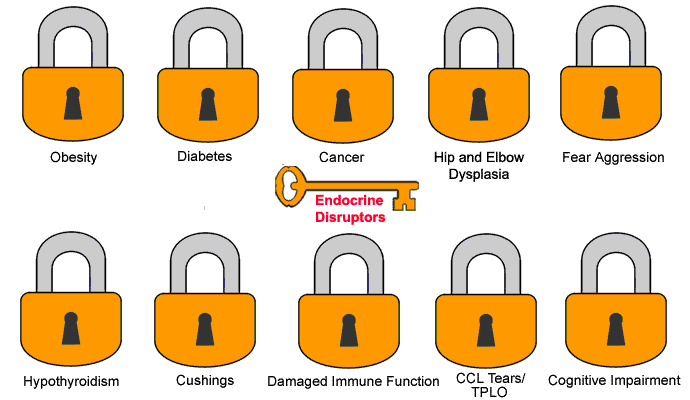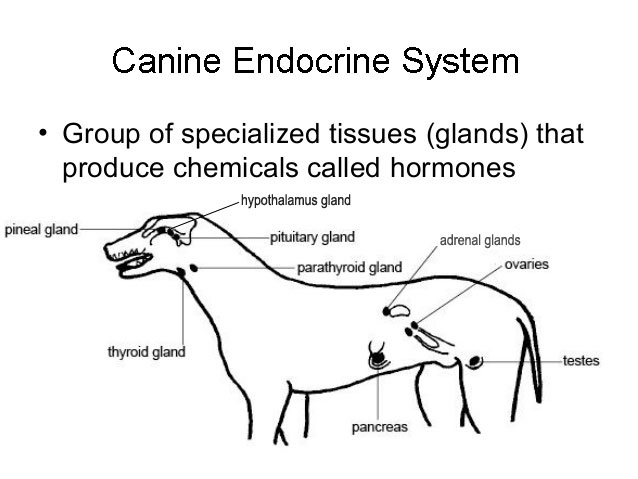Health and Happiness: the Canine-Human Connection

Many of the advances in human healthcare and science can be attributed to the fact that we are able to try various medical treatments on our canine best friends before applying them to humans. This is because, from a physiological and biological perspective, humans and canines are very similar. In fact, we routinely utilize canine models in human medical research (e.g., cardiovascular studies, cancer, heart and lung research, orthopedics, neurology).
Why did the veterinary community choose to ignore the canine-human connection when they introduced spay/neuter as a responsible means to prevent pet overpopulation some 50 years ago? Did they have long term, peer-reviewed studies supporting the safety of spay/neuter prior to its positioning as the standard of care for the sterilization of dogs? No. Absent solid research in dogs, if you look to the human experience, we knew even then that the human equivalents to spay (ovariohysterectomy) and neuter (castration) were extremely harmful to humans, and undertaken only in the case of medical necessity. Further, if these procedures were performed on humans, hormone replacement would have generally followed. Inexplicably, the veterinary community chose to ignore the human research, failed to do parallel research on canines, and then took a quantum leap further to actually promote spay/neuter as being good for dogs. Without providing adequate “informed consent“, the veterinary community recommended invasive and often unsafe sterilization procedures (spay and neuter) while rejecting the sterilization procedures we safely perform on humans, i.e., tubal ligations on females and vasectomies on males. This begs the question, why can’t vasectomies and tubal ligations be performed on our canine best friends? The short answer is, “They can!”. Please see our section “The Smoking Gun” wherein veterinary research is presented to confirm tubal ligation and vasectomy are appropriate and safer procedures to prevent dog overpopulation.
According to a 2007 systematic review 83 of more than 50 peer reviewed studies regarding the effects of spay/neuter:
“One thing is clear – much of the spay/neuter information that is available to the public is unbalanced and contains claims that are exaggerated or unsupported by evidence. Rather than helping to educate pet owners, much of it has contributed to common misunderstandings about the health risks and benefits associated of spay/neuter in dogs.”
Spay and neuter are also promoted as providing a solution to canine behavioral problems (e.g., aggression, fear and anxiety, excitability) in female and male dogs. However, as observed by Dr. Stanley Coren in Psychology Today, the latest peer-reviewed studies show that contrary to conventional wisdom, spaying/neutering was associated with significantly worse behavior. Please see sections Behavioral Effects of Spay and Behavioral Effects of Neuter for a full discussion of the current studies regarding spay/neuter and canine behavior.
Another oft-repeated aspect of spay/neuter that we must challenge is the assertion that spay/neuter lengthens the lives of our dogs. On our Lifespan page, we discredit a 2013 study supporting spay/neuter as a procedure which will enhance the lifespan of the family dog. We also introduce studies which conclude that ovarian hormones in females lay the foundation for adult health outcomes, including longevity. In fact, the “estrogen deficiency state may be characterized as a state of accelerated aging“. Further, we are able to introduce studies which demonstrate the hormonal imbalance brought on by spay/neuter negatively affects the dog’s ability to respond to stress. This inability to respond to stress creates changes in the dog again consistent with accelerated aging and consequently shortens the lifespan of spayed/neutered canines.
With respect to the legal requirement for “informed consent“, consider whether you were ever advised of the following: spay surgery itself is a complex, highly invasive procedure, and can have serious complications such as stump pyometra, ovarian remnant syndrome, and uterine stump granuloma (see our “Complications of Spay” section for references and more detail). Add to this the lifelong effects of hormonal disruption, and it becomes clear spay should not be the routinely recommended standard for sterilization. Spay is also often recommended to avoid life-threatening pyometra despite studies providing pharmaceutical and non-surgical protocols to resolve pyometra. With respect to neuter (castration), there is long term evidence regarding the medical ramifications for healthy young human males in previous societies dating back several centuries. The historical information is consistent with data/conclusions from current studies of castration. Due to the long-term medical consequences, we now opt for vasectomy in human males, so as to preserve the testes and the hormones they produce. Surgical castration of human males remains highly controversial, if not illegal, even when performed on convicted sexual predators. A review 81 of the literature on the subject of castration with respect to its medical consequences in previous societies concludes:
“Hopefully, it will never again be possible to repeat the studies reviewed in this paper, as in more recent times we have used different means of expressing man’s inhumanity to man.”
The ACLU argues surgical or chemical castration 82 of humans is considered “cruel and unusual punishment”. Why would we inflict this upon our innocent dogs without a second thought?

After spending 13 years battling behavioral and physical problems with our dog Billy, we finally came to the devastating conclusion that all of his suffering was the result of his being neutered as a young dog in a shelter. Once we came to that conclusion, we uncovered a wealth of information/research that supported our position. We were left wondering why no one in the veterinary community ever revealed to us that this was all quite predictable based solely on Billy’s being neutered at a young age.
In January of 2023 the American Veterinary Medical Association (AVMA) finally published a peer-reviewed study including over 6000 dogs. The study compared the health and behavior of spayed and neutered dogs to dogs who are left intact and dogs who are sterilized in a manner that preserves their hormones. For clarity, hormone sparing sterilization would include tubal ligation, ovary sparing spay (i.e. OSS/hysterectomy) and vasectomy (VS). Their conclusion was that a dog will live a longer, healthier life and behave better if they have normal levels of gonadal (sex) hormones produced by the ovaries (estradiol), and the testes (testosterone). This statement is taken directly from the AVMA study:
“Our most important finding was that longer duration that gonads [ovaries or testicles] were present, regardless of reproductive status, was associated with fewer general health problems and [fewer of] both problematic and nuisance behaviors. It was also associated with an increased lifespan. Because VS and OSS permit dogs to experience longer gonadal hormone exposure times, these data suggest that, when electing surgery to prevent reproduction, dogs might benefit from these alternative surgeries with respect to general health and experience better behavior outcomes compared to undergoing traditional spay-neuter surgery. Delaying traditional spay-neuter surgery could offer similar benefits.”217
We are happy to see that the AVMA (the national professional association that represents and advocates for the more than 99,500 veterinarians in the US) has finally acknowledged the harm of spay/neuter, especially early spay/neuter. However, their note that delaying spay-neuter could offer similar benefits is contradictory and in error. The idea of delaying spay or neuter until a dog has reached physical maturity as suggested in this study may help prevent orthopedic deformities, but the lifelong metabolic and behavioral issues remain. Spay or neuter is not appropriate for a healthy dog at any age. The proof is offered on the pages of this website.
Hormones are substances secreted by glands throughout your body (a more complete discussion of hormones can be found on the page, “Hormones and the Endocrine System“). Together, hormones and glands make up the endocrine system. Hormones regulate everything from hunger to reproduction and influence nearly every cell, organ, and metabolic function. In fact, human studies have documented that the estrogen hormones have 400 functions in the body. It follows that for people (or dogs) to stay healthy, hormones must be released in the right amounts, and glands must be able to adjust the release of hormones in response to a changing environment.
Removal of the ovaries and testes disrupts the production of sex hormones (i.e., testosterone, estradiol, progesterone), which, by definition, makes spay/neuter an endocrine disruptor (ED). According to the Endocrine Society’s latest Scientific Statement on the subject of EDs, the loss/reduction of sex hormones is not inconsequential:
“…levels of any hormone must be within a physiologically relevant range to be most effective. Excursions outside of that range to superphysiological (elevated) or subphysiological (depressed) levels for any extended period nearly always result in dysfunction or disease.” 176
Studies have shown the endocrine disruption caused by spay or neuter often leads to a weakened immune system, altered metabolism, chronic disorders/disease, and behavior problems. However, veterinary schools and many veterinary organizations still insist spay or neuter is healthful for dogs and should be the standard procedures to prevent dog overpopulation. This is in direct contrast to the entire thesis of the “Canine-Human Connection”.

There are a group of chemicals, both natural and man-made, that exist in our environment and are also endocrine disruptors (EDs) or endocrine disrupting chemicals (EDCs). According to the latest edition of the subject-expert reference, “Comprehensive Toxicology“:
“EDCs disrupt the endocrine system directly or indirectly by altering hormone levels, affecting the synthesis or metabolism of hormones, or changing the way hormones elicit their functions. Critical reproductive hormones, such as progestins [progesterone], androgens [testosterone], and estrogens, are the primary targets of many EDCs.” 196
The names of some of these EDs might be familiar to you and include DDT, dioxin, BPA, PFOA, atrazine (herbicide), PCBs, and arsenic. These endocrine disrupting chemicals have been studied extensively in humans and wildlife, and to our knowledge, there are no studies asserting the benefits of exposure to these chemicals.
In males, for example, DDT is one ED known to “chemically castrate“ 70 (i.e., neuter) its victims. Broadly speaking, the effects on humans of exposure to identified EDs is quite similar to the effects of spay/neuter on our young dogs. We will explore this in depth in the Diseases section of this website, where we will refer you to resources from the Hormone Health Network. The Hormone Health Network is the public education affiliate of the 100 year old Endocrine Society – the largest global membership organization representing professionals (medical doctors, scientists, researchers, and educators) from the field of endocrinology.
At a recent European Union (EU) conference on endocrine disruptors,65 R. Thomas Zoeller, PhD, an invited spokesperson for the Endocrine Society, stated:
“It’s important for regulating agencies to understand that hormones control elements of development that are irreversible when disrupted. We are facing a continuing pandemic of chronic disease if we do not act now.”
Spay/neuter is the ultimate ED, and it is never a responsible option for a young, healthy dog. Yes, we said NEVER. The conclusions of Dr. Zoeller (just above), with respect to endocrine disruptors are remarkably similar to the conclusions in a 2013 UC Davis study of the effects of spay/neuter:
“Because [spaying and] neutering can be expected to disrupt the normal physiologic developmental role of gonadal [i.e., sex] hormones on multiple organ systems, one can envision disease syndromes…”
Once a dog has been spayed or neutered, their endocrine system has been forever altered. There is no going back to optimal health, despite best efforts. In fact, we will illustrate on our Diseases Overview and the Stress Response System pages of this website how spay/neuter permanently damages your dog’s ability to respond to physical and/or psychological stress; leaving your dog increasingly susceptible to cancer, metabolic disease including diabetes, immune-related disease, infection and anxiety. The damage of spay/neuter to the endocrine system of your dog is permanent, and no dog is immune.
We will summarize the multitude of studies revealing the consequences of spay/neuter in the Spay and Neuter sections of this website (note: there are over 200 peer reviewed studies referenced in our Bibliography). We will document the developmental damage of early spay/neuter in the Orthopedic section and the emerging chronic diseases related to spay/neuter in the Hormones and the Endocrine System section of this website. The Research section explains why it is acceptable to apply the research and studies pertaining to endocrine diseases in humans as a basis for understanding the emerging disease entities in dogs. In our History section, we will discuss at great length how our dog Billy’s health problems led us to our conclusions.
In short, spay/neuter significantly increases the risk of an otherwise young, healthy dog developing:
- Orthopedic problems
- hip dysplasia
- elbow dysplasia
- CCL ligament tear in their knees (requires TPLO surgery)
- Cancer
- osteosarcoma
- hemangiosarcoma
- Lymphosarcoma
- mast cell tumor
- Diseases of the endocrine (hormone) systems
- hypothyroidism
- Cushings and Atypical Cushings
- Type 2 diabetes
- Hyperestrinism and Alopecia (hair loss)
- Allergies (atopic dermatitis)
- Obesity
- Behavior problems
- aggression towards people and other dogs
- fear and anxiety
- reactivity to touch or handling

Spay/neuter, the ultimate endocrine disruptor, is the key to the increase of all of the seemingly unrelated detrimental conditions our dogs suffer from as documented throughout this site. We recognize spay/neuter is a means to an admirable goal. However, is it ethical to compromise the right to a healthy and happy life for the individual dog for the perceived “greater good” of controlling dog overpopulation? A 2012 Texas A&M research paper 99 titled, “Inconvenient Desires: Should We Routinely Neuter Companion Animals?”, explores this very question. Summarizing their conclusions:
Routine neutering of companion animals raises significant ethical questions and from some ethical perspectives, looks highly problematic. In the case of male dogs and the long-term health risks involved, routine neutering is not morally justified.
We don’t believe any dog should be condemned to a life of pain and illness when viable alternatives which protect your dog’s hormones exist. We would strongly recommend the time and human tested procedures of tubal ligation and vasectomy as safe and ethical alternatives to conventional spay/neuter for our dogs. This solution also prevents pet overpopulation.
According to a 2001 published UC Davis Behavior Service study 55 :
“There may be a need to evaluate possible methods for counteracting the effects of loss of sex hormones in gonadectomized [i.e., having had ovaries or testes surgically removed] dogs.” (Dr. Benjamin Hart; School of Veterinary Medicine, UC Davis; J Am Vet Med Assoc 2001; 219:51–56)
Further, in 2013 60 and 2014,61 UC Davis published studies linking spay/neuter to three significant orthopedic problems and four aggressive cancers in Golden Retrievers, Labrador Retrievers and German Shepherds. In July of 2020, the research team at UC Davis followed up with studies from the same database to look at the aforementioned orthopedic problems and cancers among 35 other dog breeds as well as mixed breed dogs. The breed-specific results were intended to reveal the range of differences in disease vulnerability to spay/neuter. The researchers provide advice regarding the timing of spay/neuter to minimize these orthopedic problems and cancers within specific breeds.180 Among mixed breed dogs the major differences in vulnerability seemed to be based upon size, with dogs under 43 lbs. showing less vulnerability to the cancers and orthopedic problems specific to these studies.181 The authors point out that these studies do not take into consideration other adverse outcomes (e.g. accelerated brain aging, cognitive decline, behavioral changes) with documented association to hormone deficiencies as a result of spay/neuter. The other limitation we see with these studies is that the median age of the dogs’ last visit was 4.9 to 6.0 years old. Generally the diagnosis of the cancers in question, and often the orthopedic issues occur when the dog is older than this age range. In that circumstance, the study will not be able to record that diagnosis, and this makes the conclusions of this study less reliable.
The UC Davis studies were intended to serve a practical purpose because in their home state of California all shelter dogs are required by law to be spayed or neutered prior to adoption. Additionally, many dogs purchased from breeders are either spayed/neutered prior to release of the dog or sold with a requirement for spay/neuter at a later date. In the situation of adoption from a breeder, the information in this study may be helpful, however people adopting shelter dogs will have no input as to when the dog will be spayed or neutered. In an April 2013 interview with one of the principals for this study, Dr. Benjamin Hart (see our “Smoking Gun” page), points out that tubal ligation and vasectomy would control canine overpopulation without the increased prevalence of deadly cancers and orthopedic deformities. Why is it, then, that this information was not included in the published studies from 2020? Why does UC Davis’ clinical program fail to promote or teach tubal ligation or vasectomy?
Unfortunately, UC Davis is not the only veterinary institution failing to teach or even discuss tubal ligation or vasectomy as safer and equally effective alternatives to spay/neuter. These UC Davis studies are particularly relevant because veterinary programs and the AVMA continue to debate the timing of spay/neuter as a means to deal with some of the unintended consequences these and many other studies have revealed.108
Several veterinarians, on the condition their names be withheld, confided their belief that the financial windfall spay and neuter create for the veterinary industry has trumped the medical concerns of the affected dog (this becomes evident in our “Hidden Costs of Spay/Neuter” page). Consequently, it appears that change will only occur as a response to pressure from pet guardians. In fact, the authors of a study109 evaluating the risks of spay/neuter upon Vizslas, direct their peers to discuss the harmful effects of spay/neuter with their canine guardians as part of the requisite “informed consent” process. In order to ensure you get the necessary information to make a good decision regarding your dog’s care, it would be appropriate for you to introduce/reacquaint your veterinarian to a concept known in human medicine as “shared decision making“63 (SDM). Sharing decisions by way of providing information, as opposed to clinicians making decisions on behalf of patients, is gaining increasing prominence in health care policy. SDM has been defined as:
“…an approach where clinicians and patients share the best available evidence when faced with the task of making decisions, and where patients are supported to consider options, to achieve informed preferences”.
Pet guardians should be apprised of the option of tubal ligation/vasectomy with the understanding the pet guardian will need to exercise some judgment/restraint of both male and female dogs when a female dog is in heat.
Pressure from pet guardians to move from spay/neuter to tubal ligation/vasectomy has historically been fueled by breed-specific organizations who are studying the effects of spay/neuter upon their particular breed. One example of this is the Morris Animal Foundation Golden Retriever Study, which was undertaken due to the high incidence of cancer, obesity and orthopedic conditions exhibited specifically in Golden Retrievers. Although they are studying genetics, environment, diet and many factors affecting the incidence of these conditions, early results are pointing directly to spay/neuter as a major culprit for the increased incidence of all three.
This 2023 study by the AVMA should be a game changer. Dog guardians can now demand tubal ligation, OSS, and vasectomy as a method of population control, with the qualified support of the AVMA. We are told by experts in the field that these procedures are simpler (from a technical perspective), have fewer complications and should ultimately be less costly. This should appeal to shelter managers and other custodians of the bottom line as well. Veterinary surgeons can be educated to perform these surgical procedures. If you have difficulty locating a veterinarian in your area who is capable and willing to perform hormone sparing sterilization alternatives to traditional spay/neuter (e.g., vasectomy, tubal ligation, ovary-sparing spay), we recommend that you refer to our Frequently Asked Questions (FAQ) or our Facebook page.
If you visit our Legal section you will see that in 2016, both the American Veterinary Medical Association (AVMA) and the American Society for the Prevention of Cruelty to Animals (ASPCA) only recognized/recommended spay/neuter as legitimate methods of preventing pet overpopulation. Therefore, the 2023 AVMA study is a major policy change, especially because it recognizes as superior other hormone-sparing procedures specifically. Currently the ASPCA recommends “sterilization” which would also allow for hormone-sparing procedures as we are advocating.
Thirty-one states and the District of Columbia currently require that pets adopted from shelters be specifically spayed or neutered before they leave the facility. These laws MUST be changed immediately to mandate “sterilization” which could include TL, OSS, or VS, not just spay or neuter. Please visit our Legal section for information regarding each state’s law and a detailed discussion on how to change your state law if necessary.

If your current dog has already been spayed/neutered, the damage has most likely already been done to a large extent. We will do our best to advise you of offsetting measures that were somewhat successful for our dog and/or currently available methods of HRT (hormone replacement therapy) that we discover over time in our research. We ask that you please work with us to change the status quo for all pets – present and future.
This website is dedicated to Billy.
Disclaimer: Healthy and Happy Dog is intended to provide information helpful to dog guardians, and hopefully veterinarians, as a public service. We do not accept any advertising nor do we promote any products or services.
